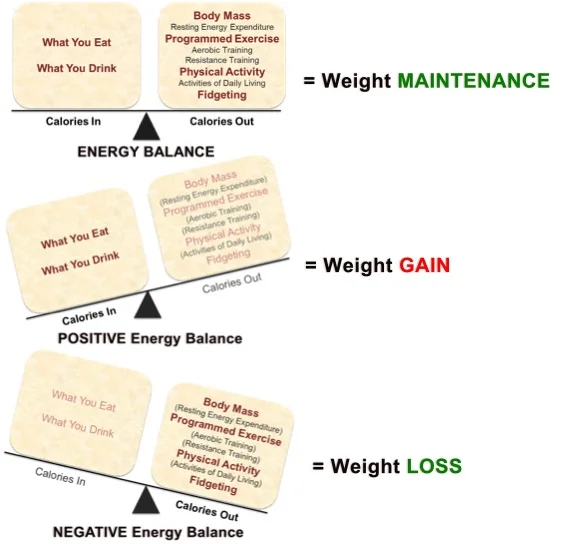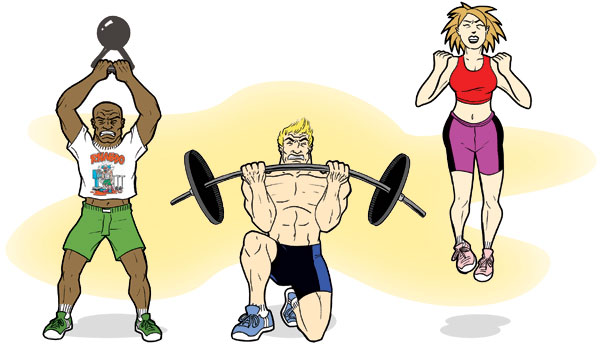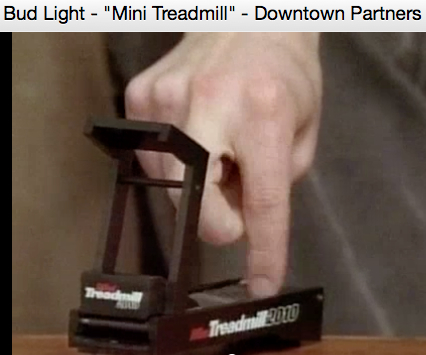Calories IN and Calories OUT Determine Body Mass,
Not a Magical Macronutrient Formula
Instead of dieting, I would like you to focus on energy balance. In nutrition, energy balance is a state where the amount of energy you consume (eat) equals the amount of energy you expend (burn) and can be summed up by the simple equation:
calories in = calories out
When calories in = calories out, your body weight will remain stable and you are in a state of energy balance. If you alter one side of the equation or the other, your body weight will change accordingly. For example, if you eat more calories than you burn (calories in > calories out) you are in a positive energy balance and you will gain weight. On the other hand if you burn more calories than you take in (calories in < calories out) you are in a negative energy balance and you will lose weight.
weight loss: calories in < calories out
weight maintenance: calories in = calories out
weight gain: calories in > calories out
Many people, including nutritionists and fitness experts, will vehemently argue that maintaining or changing body weight cannot possibly be this simple: but it is! They want you to believe that weight loss is a complicated process that they understand but you do not. They can then use your "lack of understanding", fear, and anxiety to sell you goods and services that you probably do not need and are not helpful. For those individuals who claim to have a “slow” metabolism, the energy balance equation still holds true. The number of calories required to maintain body weight may be slightly lower than one of his/her peers, but again, the equation holds true. But do not despair! The human body is an amazing machine that is capable of adapting to extraordinarily diverse challenges and circumstances. If your metabolism is “slow”, don’t worry, you can change it through increasing the calories out side of the equation (movement, activity, and exercise).
There are two sides to the Energy Balance Equation: Calories In and Calories Out. Many people are only concerned with the Calories In side of the equation. It is true that reducing caloric intake is the most effective way to lose weight (1, 2, 3) but the Calories Out side of the equation is also important. Calories Out are primarily a function of your body mass, programmed exercise, physical activity, and fidgeting. Having control over Calories Out is key in maintaining your weight, or keeping the weight you worked so hard to lose, off (4, 5).
*Please note: the Thermic Effect of Food (TEF) was not included in this figure. Although the TEF contributes to both sides of the equation, manipulation of the TEF on its own does not change body composition (6).
- Body Mass: the more you weigh on the scale, the greater your at rest calorie expenditure is. Regardless of body composition, an individual who weighs 250 pounds requires more calories to maintain that body mass than someone who weighs 200 pounds.
- Programmed Exercise: exercise that is planned out, such as aerobic exercise (e.g., running) and/or resistance training (e.g., lifting weights), is great for burning calories and tipping the scale towards negative energy balance and weight loss.
- Physical Activity: includes all daily movement that is not planned out for the primary purpose of fitness or energy expenditure, rather it consists of all movement outside of planned exercise. It includes activities of daily living such as brushing your teeth, housework, walking, and gardening.
- Fidgeting: describes the movement individuals make unconsciously such as shaking a leg or a foot or tapping a pencil on a desk repetitively. This type of activity cannot be planned, taught, or incorporated into one's day. You either have it or you don't.
- *Thermic Effect of Food (TEF): the energy required to digest, absorb, transport, and store the nutrients you consume. The TEF does play a key role in weight gain and weight loss but is an uncontrollable factor, the manipulation of which does not contribute to changes in body composition (6).
Body Mass
Reference: (7). Jequier, E. Energy metabolism in human obesity. Soz Praventivmed. 1989;34(2):58-62. Note that in the above example body weight is expressed in kilograms (kg) and not pounds. To convert your weight in pounds to kilograms, divide by 2.2.
Programmed Exercise
Programmed exercise is a great way to burn calories at an accelerated rate and is recommended to maintain a healthy lifestyle (2); however, much to the fitness enthusiast's surprise, not everyone enjoys programmed exercise. In some cases people may go a little overboard with their fitness routines (see cartoon above).
Physical Activity
Physical Activity is a very important contributor to overall health and metabolic fitness and can be easily incorporated into one's activities of daily living whether it be (from left to right) cheering for friends at a race, biking around the city, canoeing/kayaking, playing in the sand, climbing a tree, hiking, ice fishing, rolling out a snowball, or shoveling snow. Each of these actives requires caloric expenditure and can be done in a playful, fun manner, rather than a pre-programmed sometimes painful manner.
Fidgeting
Frequent fidgeting is a trait you either have or you don't. We do not have the time to think about trying to fidget during the day to burn calories. The picture above of the "Mini Treadmill" was taken from a Bud Light ad in which they satirically pointed out that 10 calories of carbohydrates could be easily burned by utilizing their mini treadmill. Trying to fidget throughout the day to lose weight makes about as much sense as using the mini treadmill. We should instead, try to focus on things we can control.
References:
Donnelly JE, Smith BK. Is exercise effective for weight loss with ad libitum diet? Energy balance, compensation, and gender differences. Exerc. Sport Sci. Rev. Oct 2005;33(4):169-174.
Donnelly JE, Blair SN, Jakicic JM, Manore MM, Rankin JW, Smith BK. American College of Sports Medicine Position Stand. Appropriate physical activity intervention strategies for weight loss and prevention of weight regain for adults. Med. Sci. Sports Exerc. Feb 2009;41(2):459-471.
Melanson EL, Keadle SK, Donnelly JE, Braun B, King NA. Resistance to exercise-induced weight loss: compensatory behavioral adaptations. Med. Sci. Sports Exerc. Aug 2013;45(8):1600-1609.
Klem ML, Wing RR, McGuire MT, Seagle HM, Hill JO. A descriptive study of individuals successful at long-term maintenance of substantial weight loss. Am. J. Clin. Nutr. Aug 1997;66(2):239-246.
Wing RR, Phelan S. Long-term weight loss maintenance. Am. J. Clin. Nutr. Jul 2005;82(1 Suppl):222S-225S.
La Bounty PM, Campbell BI, Wilson J, et al. International Society of Sports Nutrition position stand: meal frequency. J. Int. Soc. Sports Nutr. 2011;8:4.
Jequier E. Energy metabolism in human obesity. Soz Praventivmed. 1989;34(2):58-62
Sources for Pictures:
- Programmed Exercise cartoon: hellonheelshon.com/goodbye-fancy-gym/
- Fidgeting - Mini Treadmill: http://www.youtube.com/watch?v=k2iCYbmS1CA













